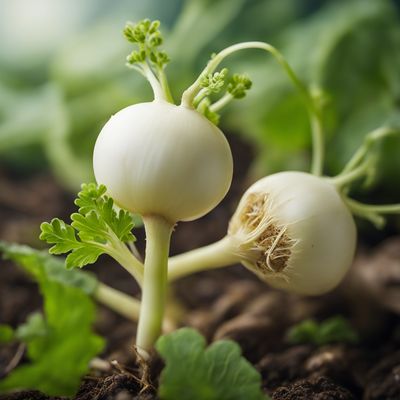
Ingredient
Parsley roots and similar-
The Hidden Gems of the Herb Garden: Unveiling the Versatility of Parsley Roots and Similar Ingredients
Parsley roots are the edible taproots of the parsley plant, resembling parsnips in appearance. They have a creamy white color and a slender, elongated shape. The roots have a firm texture and a slightly sweet, earthy flavor that is milder than parsnips. They are often used as a supporting ingredient to add depth and complexity to dishes. Similar ingredients include celeriac, turnips, and carrots, which share similar characteristics and can be used interchangeably in recipes.
Origins and history
Parsley roots have been cultivated for centuries and are believed to have originated in the Mediterranean region. They were highly valued in ancient Greece and Rome for their medicinal properties and were later introduced to other parts of Europe. Today, parsley roots are grown in various countries around the world, including France, Germany, and the United States.
Nutritional information
Parsley roots are a good source of dietary fiber, vitamin C, and vitamin K. They are low in calories and contain essential minerals such as potassium and manganese.
Allergens
There are no known allergens associated with parsley roots and similar ingredients.
How to select
When selecting parsley roots, look for firm roots with smooth skin and no signs of browning or soft spots. Choose roots that are medium-sized, as larger roots may be woody and less flavorful. For similar ingredients like celeriac and turnips, select ones that are firm and heavy for their size, with no signs of mold or softness.
Storage recommendations
To maintain freshness, parsley roots should be stored unwashed in a perforated plastic bag in the refrigerator's crisper drawer. They can last for up to two weeks when stored properly. Similar ingredients like celeriac and turnips can also be stored in the refrigerator, but they may have a shorter shelf life.
How to produce
Parsley roots can be grown from seeds or transplants. Plant them in well-drained soil in a sunny or partially shaded location. Keep the soil consistently moist but not waterlogged. Harvest the roots when they reach a desirable size, usually after 90-120 days. Similar ingredients like celeriac and turnips can be grown using similar methods.
Preparation tips
Before using parsley roots, scrub them thoroughly to remove any dirt or debris. They can be peeled or left unpeeled, depending on personal preference. Parsley roots can be roasted, sautéed, or added to soups and stews for added flavor and texture. They can also be grated and used raw in salads. Similar ingredients like celeriac and turnips can be prepared in similar ways.
Substitutions
If parsley roots are not available, celeriac, turnips, or carrots can be used as suitable substitutes. Celeriac offers a similar earthy flavor, while turnips provide a slightly sharper taste. Carrots can add a touch of sweetness to dishes.
Culinary uses
Parsley roots and similar ingredients are versatile and can be used in a variety of culinary applications. They can be roasted and served as a side dish, added to soups and stews for added depth of flavor, or grated and used raw in salads. They can also be pureed and used as a base for creamy soups or mashed as a substitute for potatoes.
Availability
Parsley roots and similar ingredients are commonly available in Europe, particularly in countries like France, Germany, and the United Kingdom. They can also be found in some specialty grocery stores or farmers markets in the United States.
More ingredients from this category

Burnet saxifrage roots
Burnet Saxifrage: A Hidden Gem of Culinary Delights

Turnip-rooted chervil
Delicate Herb with a Peppery Twist

Nettle roots
The Hidden Gem: Nettle Roots

Lovage roots
The Versatile Lovage Roots

Parsley roots
The Hidden Gem of Parsley

Angelica roots
The Healing Power of Angelica Roots